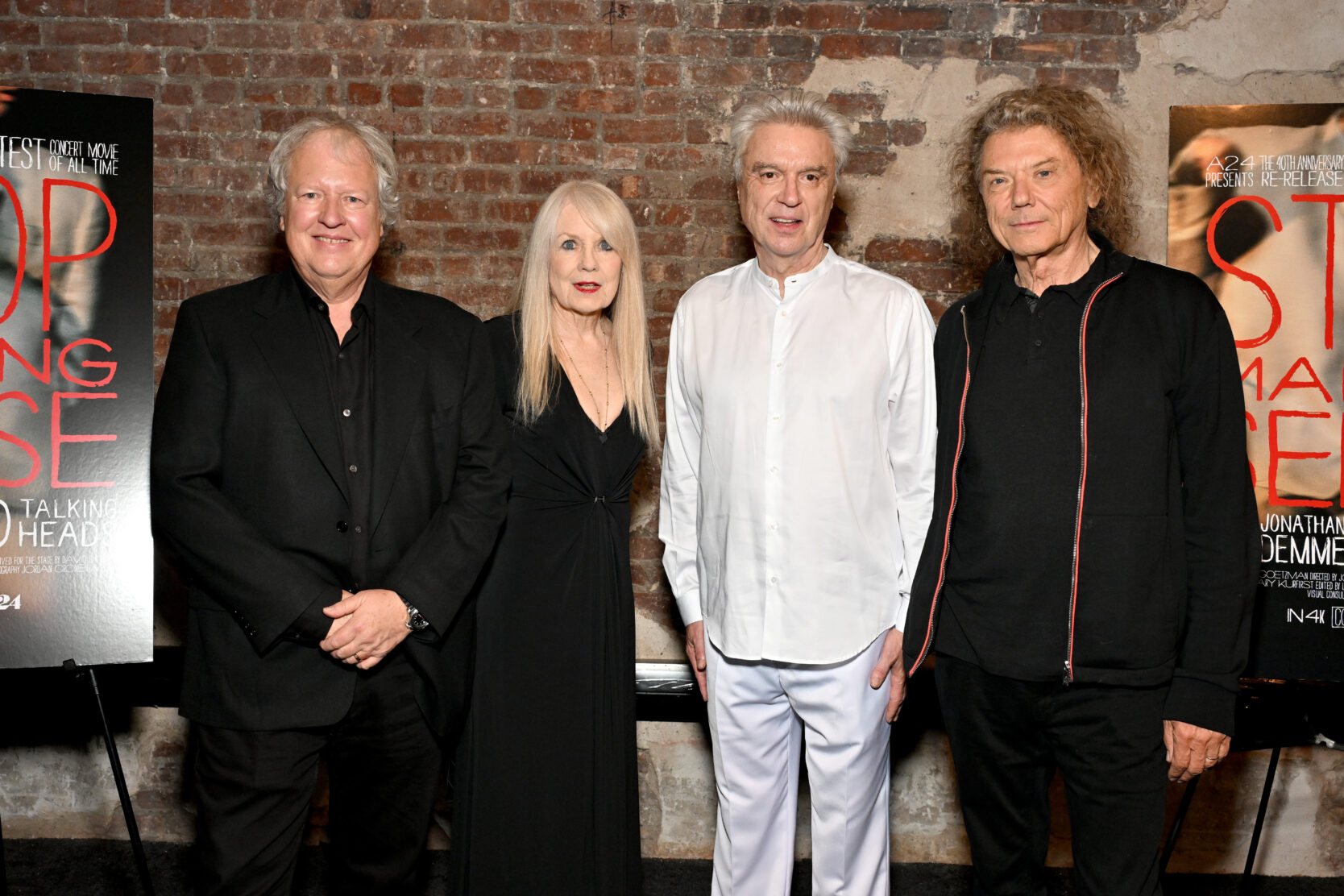The quintessential art school band of our time began at Rhode Island School of Design, where singer/guitarist David Byrne started the Artistics with drummer Chris Frantz. Frantz’s girlfriend and eventual wife Tina Weymouth then became the band’s bassist as they relocated to New York and adopted the name Talking Heads. Opening for the Ramones at CBGB for their first show in 1975, Talking Heads became the quirky, bookish counterpoint to the more brash, Stooges-inspired bands defining New York’s first wave of punk rock. Jerry Harrison, formerly of the Modern Lovers, completed the quartet in time for their debut album, Talking Heads: 77.
Covering Al Green and collaborating with members of Parliament-Funkadelic, Talking Heads embraced R&B and Afrobeat influences while exploring more futuristic sounds and abstract lyrics on a trilogy of classic albums with British producer Brian Eno. By the mid-‘80s, they were a regular presence on MTV and mainstream radio, making subversively catchy platinum albums even after they ceased touring in 1984. In 1991, Byrne’s colleagues learned from an interview in the Los Angeles Times that he’d decided to break up the band, and things remained publicly tense between them for most of the last three decades.
Still, the music continues to inspire across generations and genres. In celebration of its 40th anniversary, the band’s iconic 1983 Jonathan Demme-directed concert film Stop Making Sense was recently re-released in theaters by A24. The occasion was significant enough for Byrne, Frantz, Weymouth and Harrison that they assembled for the first time since their 2002 Rock and Roll Hall of Fame induction for promo appearances at the Toronto International Film Festival and on The Late Show with Stephen Colbert, with two more special events planned next month in New York and Los Angeles.
All this activity raises the question of where Stop Making Sense ranks alongside the band’s other studio albums. You may now ask yourself …
10. Naked (1988)
For their recorded swan song and only album helmed by producer Steve Lillywhite (U2, Peter Gabriel), the quartet jammed extensively in the studio in Paris on a set of instrumentals that brought back some of the funky international flavor of their early ‘80s work. Then Byrne, who’d soon launch his Luaka Bop label and record a solo album, wrote and recorded lyrics for Naked in New York. Weymouth plays some of her most nimble and impressive basslines on “Blind” and “The Democratic Circus,” but Naked almost completely lacks the kind of instantly memorable songs well-represented on the band’s other albums. “The band eschews the stripped-down four-piece rock approach of late for a far more eclectic big-band, world music extravaganza,” Chris Willman wrote in the Los Angeles Times review of Naked.
9. True Stories (1986)
In October 1986, the cover of Time trumpeted Byrne as “rock’s renaissance man: singer, composer, lyricist, guitarist, film director, writer, actor, video artist, designer, photographer.” Despite the media hype, Byrne’s debut feature film True Stories only made $2.5 million at the box office, and the companion album of the same name sold a fraction as much as the previous Talking Heads release. In the gently satirical film about the fictional small town Virgil, Tx., the songs are often sung by actors such as John Goodman and Annie McEnroe. On the album, however, the songs are presented as Talking Heads tracks with Byrne vocals, some of the most straightforward pop/rock tunes in their catalog. The singalong appeal of the album’s only hit, “Wild Wild Life,” is undeniable, but for the first time some blandness was creeping in. The sunny, accordion-driven “Radio Head” would inspire the name of a young British band who’d become a household name before too long, but True Stories feels like the Talking Heads with the least influence on future generations of art rockers.
8. Talking Heads: 77 (1977)
The first wave of albums by CBGB bands includes such epochal, legacy-defining classics as The Ramones, Television’s Marquee Moon and Patti Smith’s Horses. By that lofty standard, Talking Heads: 77 is a comparatively lightweight album by a band whose best work was still ahead of them. Producer Tony Bongiovi, cousin of future rock star Jon Bon Jovi, had famously bad chemistry with the band, asking Byrne to hold a kitchen knife to get into character while recording the vocal for “Psycho Killer.” That strikingly cinematic song is, however, far and away the high point of an otherwise tentative album the band began recording as a trio before Harrison had joined. “Don’t Worry About the Government” and “The Book I Read” don’t exactly sound like punk rock in the fast and aggressive way soon to be codified as a genre, but Talking Heads were subverting rock conventions in strange enough ways to make sense as part of the new rebellion.
7. Little Creatures (1985)
Little Creatures isn’t remembered now as the high point of Talking Heads’ career, but at the time it was their commercial and critical pinnacle (it’s their only multi-platinum album). The band were still relative eccentrics in a rock radio landscape dominated by the likes of Huey Lewis and Dire Straits, but “And She Was,” “Road to Nowhere” and “Stay Up Late” are all proof that beneath the tics and hollers, Byrne was a world-class melodist with a wonderful singing voice. Only “Walk It Down” features remnants of the synthy funk that dominated the band’s output for several years up to that point.
6. Stop Making Sense (1984)
Demme’s Stop Making Sense increasingly feels like the document that rightfully defines Talking Heads in the public imagination more than any one song, studio album or music video. The companion album doesn’t feel essential in the same way, at least not the original 1984 LP, for which the questionable choice was made to trim the set down to nine songs. Still, it’s a fine live album, even without the film’s visually arresting staging, and features the fantastic full-band version of “What A Day That Was,” originally released by Byrne in 1981 on his soundtrack for Twyla Tharp’s dance project The Catherine Wheel.
5. The Name of This Band Is Talking Heads (1982)
Two years before Stop Making Sense, Talking Heads released a more conventional double LP live album, culled from years of recordings capturing their rapid evolution from 1977 to 1980. The first half includes energetic renditions of Talking Heads: 77 songs, including “Psycho Killer” with a markedly different second verse, and great early non-LP cuts like “Clean Break” and “Love → Building on Fire.” That provides the perfect context for a revelatory second half, with some of the headier studio creations from Remain in Light and Fear of Music played by an expanded lineup including Adrian Belew and Bernie Worrell.
4. Speaking in Tongues (1983)
Talking Heads may be one of the only bands in history whose work got more polished and commercial when they started self-producing their albums. That’s not a bad thing per se, particularly in the case of Speaking in Tongues, which presents a cleaner, more spacious version of the synth-heavy grooves the band cultivated on its Brian Eno-produced work. “Burning Down the House” was the Funkadelic-inspired smash that finally gave the band a top 10 pop hit, while “This Must Be the Place (Naïve Melody)” is the most beautiful and emotionally affecting song in the Talking Heads catalog. The atypical track initially underperformed as a single but is now the album’s biggest streaming hit – a staple of weddings and film soundtracks covered by everyone from Arcade Fire to jazz futurists BADBADNOTGOOD. “This LP consummates the Heads’ marriage of art-school intellect and dance-floor soul,” David Fricke wrote in the Rolling Stone review of Speaking in Tongues.
3. Fear of Music (1979)
In 1975, Eno published the first edition of Oblique Strategies, a box of cards printed with suggestions for artists and musicians when faced with writer’s block or creative indecision. When Byrne had a hard time writing lyrics for the third Talking Heads album a few years later, Eno came up with a new strategy on the spot, suggesting the singer write out a “table of contents” of themes for the album. That list of nouns turned into the bulk of the song titles on Fear of Music, including “Paper,” “Air,” “Drugs” and “Animals,” but in true Talking Heads fashion, Byrne never explores those topics in quite the way you’d expect. The few songs that didn’t come out of that technique include the haunting, almost nightmarish rocker “Memories Can’t Wait” and “Life During Wartime,” a disco crossover hit despite the refrain of “This ain’t no party, this ain’t no disco.”
2. Remain in Light (1980)
Talking Heads toyed with new ways of writing on Fear of Music, and took a jump off the deep end on Remain in Light, with Fela Kuti-inspired rhythms, electronic texture and stream-of-consciousness lyrics pushed to the forefront. The first four uptempo tracks here build and build, with the strange, crowded mix of sounds suddenly coalescing into the perfect pop song “Once in a Lifetime.” In contrast, the last four cuts descend into a fog of creeping tempos and increasingly ominous vibes such as on “Listening Wind” and “The Overload.” Remain in Light is the band’s most influential release, largely because nobody has ever made an album that moves quite like this. It’s a twitchy and bewitching masterpiece of rhythm and texture.
1. More Songs About Buildings and Food (1978)
The second Talking Heads album’s self-deprecating title plays on the cliché that sophomore LPs are often comprised of leftovers from the debut (an idea reinforced by the fact that the only single was a cover). Don’t let the relatively unassuming More Songs About Buildings and Food fool you, though – it’s a perfect album, including Talking Heads’ gloriously full-bodied reimagining of Al Green’s “Take Me to the River.” The band’s first collaboration with Eno has more modest studio effects than what they’d explore together later, like the wobbly echo on the drums on “Warning Sign” and the spacey synths on “Stay Hungry.” It’s a huge step up from Talking Heads: 77 in capturing the band’s chemistry, though. The band’s rhythm section is relentless and versatile, Harrison’s keyboard and second guitar add generous dimensions to every melody and Byrne makes wry commentary out of the very nature of human creativity on “Found a Job” and “Artists Only.”





